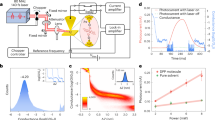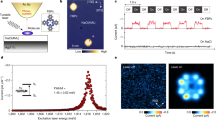Abstract
Electron transfer plays a crucial part in many chemical reactions1,2, including photosynthesis, combustion and corrosion. But even though redox-state transitions change the electronic structure of the molecules involved, mapping these changes at the single-molecule level is challenging. Scanning tunnelling microscopy provides insights into the orbital structure3 of single molecules and their interactions4,5, but requires the use of a conductive substrate that keeps molecules in a given charge state and thereby suppresses redox-state transitions. Atomic force microscopy can be used on insulating substrates to obtain structural6 and electrostatic7,8 information but does not generally access electronic states. Here we show that when synchronizing voltage pulses that steer electron tunnelling between a conductive atomic force microscope tip and a substrate with the oscillation of the tip, we can perform tunnelling experiments on non-conductive substrates and thereby map the orbital structure of isolated molecules as a function of their redox state. This allows us to resolve previously inaccessible electronic transitions in space and energy and to visualize the effects of electron transfer and polaron formation on individual molecular orbitals. We anticipate that our approach will prove useful for the investigation of complex redox reactions and charging-related phenomena with sub-ångström resolution.
This is a preview of subscription content, access via your institution
Access options
Access Nature and 54 other Nature Portfolio journals
Get Nature+, our best-value online-access subscription
$29.99 / 30 days
cancel any time
Subscribe to this journal
Receive 51 print issues and online access
$199.00 per year
only $3.90 per issue
Buy this article
- Purchase on Springer Link
- Instant access to full article PDF
Prices may be subject to local taxes which are calculated during checkout




Similar content being viewed by others
Data availability
The data that support the findings of this study are available from the corresponding author on reasonable request.
References
Marcus, R. A. Electron transfer reactions in chemistry: theory and experiment (Nobel lecture). Angew. Chem. Int. Ed. 32, 1111–1121 (1993).
Bauer, A., Westkämper, F., Grimme, S. & Bach, T. Catalytic enantioselective reactions driven by photoinduced electron transfer. Nature 436, 1139–1140 (2005).
Repp, J., Meyer, G., Stojković, S. M., Gourdon, A. & Joachim, C. Molecules on insulating films: scanning-tunneling microscopy imaging of individual molecular orbitals. Phys. Rev. Lett. 94, 026803 (2005).
Imada, H. et al. Real-space investigation of energy transfer in heterogeneous molecular dimers. Nature 538, 364–367 (2016).
Zhang, Y. et al. Visualizing coherent intermolecular dipole-dipole coupling in real space. Nature 531, 623–627 (2016).
Gross, L., Mohn, F., Moll, N., Liljeroth, P. & Meyer, G. The chemical structure of a molecule resolved by atomic force microscopy. Science 325, 1110–1114 (2009).
Gross, L. et al. Measuring the charge state of an adatom with noncontact atomic force microscopy. Science 324, 1428–1431 (2009).
Steurer, W., Fatayer, S., Gross, L. & Meyer, G. Probe-based measurement of lateral single-electron transfer between individual molecules. Nat. Commun. 6, 8353 (2015).
Giessibl, F. J. Atomic resolution on Si(111)-(7×7) by noncontact atomic force microscopy with a force sensor based on a quartz tuning fork. Appl. Phys. Lett. 76, 1470–1472 (2000).
Johnson, J. P., Zheng, N. & Williams, C. C. Atomic scale imaging and spectroscopy of individual electron trap states using force detected dynamic tunnelling. Nanotechnology 20, 055701 (2009).
Wang, R. & Williams, C. C. Dynamic tunneling force microscopy for characterizing electronic trap states in non-conductive surfaces. Rev. Sci. Instrum. 86, 093708 (2015).
Lotze, C., Corso, M., Franke, K. J., von Oppen, F. & Pascual, J. I. Driving a macroscopic oscillator with the stochastic motion of a hydrogen molecule. Science 338, 779–782 (2012).
Cockins, L. et al. Energy levels of few-electron quantum dots imaged and characterized by atomic force microscopy. Proc. Natl Acad. Sci. USA 107, 9496–9501 (2010).
Steurer, W., Gross, L. & Meyer, G. Local thickness determination of thin insulator films via localized states. Appl. Phys. Lett. 104, 231606 (2014).
Fatayer, S. et al. Reorganization energy upon charging a single molecule on an insulator measured by atomic force microscopy. Nat. Nanotechnol. 13, 376–380 (2018).
Neese, F. The ORCA program system. WIRES Comput. Mol. Sci. 2, 73–78 (2012).
Szabo, A. & Ostlund, N. S. Modern Quantum Chemistry: Introduction to Advanced Electronic Structure Theory (Courier Corporation, North Chelmsford, 2012).
Repp, J., Meyer, G., Olsson, F. E. & Persson, M. Controlling the charge state of individual gold adatoms. Science 305, 493–495 (2004).
Schulz, F. et al. Many-body transitions in a single molecule visualized by scanning tunnelling microscopy. Nat. Phys. 11, 229–234 (2015).
Wachowiak, A. et al. Visualization of the molecular Jahn-Teller effect in an insulating K4C60 monolayer. Science 310, 468–470 (2005).
Uhlmann, C., Swart, I. & Repp, J. Controlling the orbital sequence in individual Cu-phthalocyanine molecules. Nano Lett. 13, 777–780 (2013).
Setvin, M. et al. Direct view at excess electrons in TiO2 rutile and anatase. Phys. Rev. Lett. 113, 086402 (2014).
Esch, F. et al. Electron localization determines defect formation on ceria substrates. Science 309, 752–755 (2005).
Stähler, J., Deinert, J. C., Wegkamp, D., Hagen, S. & Wolf, M. Real-time measurement of the vertical binding energy during the birth of a solvated electron. J. Am. Chem. Soc. 137, 3520–3524 (2015).
Li, B. et al. Ultrafast interfacial proton-coupled electron transfer. Science 311, 1436–1440 (2006).
Miller, A. D. et al. Electron solvation in two dimensions. Science 297, 1163–1166 (2002).
O’Driscoll, L. J. et al. Electrochemical control of the single molecule conductance of a conjugated bis(pyrrolo)tetrathiafulvalene based molecular switch. Chem. Sci. 8, 6123–6130 (2017).
Holstein, T. Studies of polaron motion: part II. The ‘small’ polaron. Ann. Phys. 8, 343–389 (1959).
Toroz, D., Rontani, M. & Corni, S. Proposed alteration of images of molecular orbitals obtained using a scanning tunneling microscope as a probe of electron correlation. Phys. Rev. Lett. 110, 018305 (2013).
Wang, R., King, S. W. & Williams, C. C. Atomic scale trap state characterization by dynamic tunneling force microscopy. Appl. Phys. Lett. 105, 052903 (2014).
Payne, A., Ambal, K., Boehme, C. & Williams, C. C. Atomic-resolution single-spin magnetic resonance detection concept based on tunneling force microscopy. Phys. Rev. B 91, 195433 (2015).
Cocker, T. L., Peller, D., Yu, P., Repp, J. & Huber, R. Tracking the ultrafast motion of a single molecule by femtosecond orbital imaging. Nature 539, 263–267 (2016).
Acknowledgements
We thank L. Gross, S. Fatayer, F. Giessibl, F. Evers, R. Huber and G. Meyer for discussions. Financial support from the Marie Curie Initial Training Network ‘MOLESCO’ (number 606728) and Deutsche Forschungsgemeinschaft (numbers RE2669/6-1 and GRK 1570) is gratefully acknowledged.
Reviewer information
Nature thanks C. Williams and the other anonymous reviewer(s) for their contribution to the peer review of this work.
Author information
Authors and Affiliations
Contributions
All authors designed and performed the experiments and analysed the data. L.L.P. and J.R. were responsible for DFT calculations and co-wrote the paper. All authors revised the manuscript.
Corresponding authors
Ethics declarations
Competing interests
The authors declare no competing interests.
Additional information
Publisher’s note: Springer Nature remains neutral with regard to jurisdictional claims in published maps and institutional affiliations.
Extended data figures and tables
Extended Data Fig. 1 Scheme and detailed shape of a.c.
voltage pulses.
Extended Data Fig. 2 Orbital confinement upon electron transfer in pentacene.
a, b, Electronic transitions probed by the same metal tip apex (A = 1 Å): 0→1− (a; Vd.c. = 1.87 V, Va.c. = 1.00 Vpp, Δz = 2 Å); 1−→0 (b; Vd.c. = 1.87 V, Va.c. = 1.50 Vpp, Δz = 2 Å). Δz is given with respect to an AFM setpoint of Δf = −3.2 Hz at Vd.c. = 0 V. Scale bar, 5 Å. c, Line profiles taken along the directions indicated in a and b.
Extended Data Fig. 3 Modulus square of calculated orbitals for neutral and negatively charged CuPc.
a, b, Constant-height cuts of the superposition of degenerate LUMOs (a) and of only one of the degeneracy-lifted LUMOs (b). Scale bar, 5 Å.
Extended Data Fig. 4 Dissipation signal as a function of tip–sample distance.
Spectrum acquired above the centre of an isolated pentacene molecule (Vd.c. = 1.76 V, Va.c. = 1.00 V, A = 1 Å, 0→1−). Δz is given with respect to an AFM setpoint of Δf = −3.2 Hz at Vd.c. = 0 V. Signal saturation is observed at short tip–sample distances because not more than one electron per set pulse can be transferred.
Extended Data Fig. 5 Imaging of electronic transitions in constant-detuning mode.
a, AFM topography image (Δf = −28.5 Hz, Vd.c. = 1.60 V, Va.c. = 1.00 V, A = 1 Å) of an isolated pentacene molecule on NaCl. b, Simultaneously acquired dissipation channel, corresponding to the 0→1− transition.
Rights and permissions
About this article
Cite this article
Patera, L.L., Queck, F., Scheuerer, P. et al. Mapping orbital changes upon electron transfer with tunnelling microscopy on insulators. Nature 566, 245–248 (2019). https://doi.org/10.1038/s41586-019-0910-3
Received:
Accepted:
Published:
Issue Date:
DOI: https://doi.org/10.1038/s41586-019-0910-3
This article is cited by
-
Charge-state lifetimes of single molecules on few monolayers of NaCl
Nature Communications (2023)
-
Single-molecule electron spin resonance by means of atomic force microscopy
Nature (2023)
-
Internal Stark effect of single-molecule fluorescence
Nature Communications (2022)
-
Investigation of electronic excited states in single-molecule junctions
Nano Research (2022)
-
Subcycle contact-free nanoscopy of ultrafast interlayer transport in atomically thin heterostructures
Nature Photonics (2021)
Comments
By submitting a comment you agree to abide by our Terms and Community Guidelines. If you find something abusive or that does not comply with our terms or guidelines please flag it as inappropriate.



